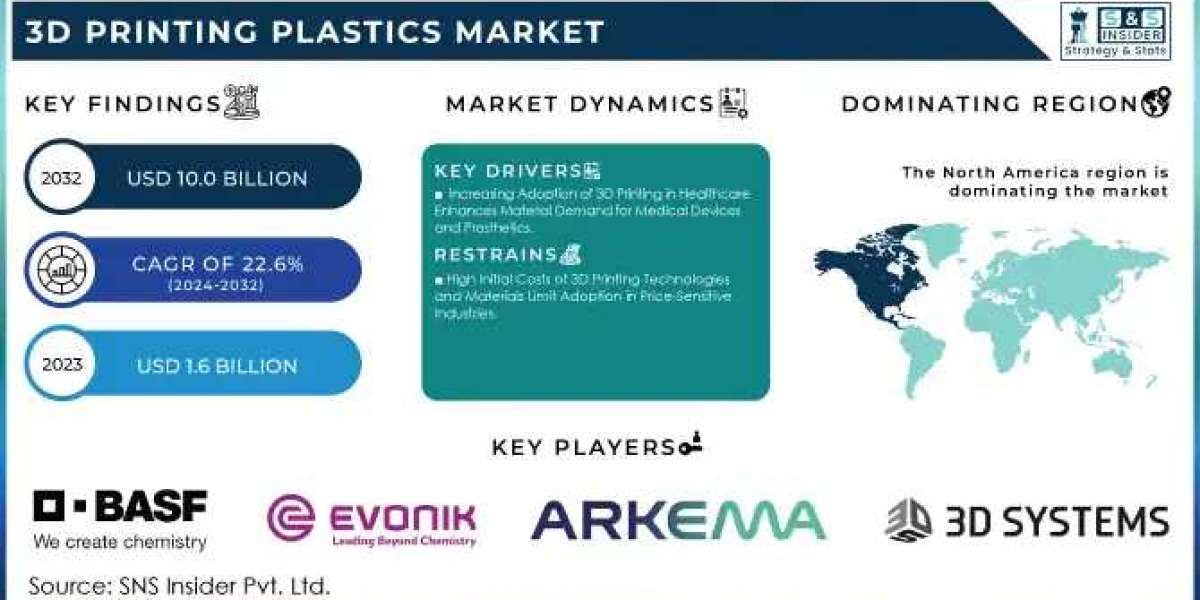The 3D Printing Plastics Market Size was valued at USD 1.6 billion in 2023 and is expected to reach USD 10.0 billion by 2032 and grow at a CAGR of 22.6% over the forecast period 2024-2032.
The 3D Printing Plastics Market has seen remarkable growth driven by advancements in additive manufacturing technology and the increasing demand for customized, high-performance materials. As industries such as aerospace, automotive, medical, and consumer goods look for more efficient, cost-effective production methods, 3D printing plastics have become a vital solution. These plastics, including ABS, PLA, nylon, and photopolymer resins, offer unique advantages in rapid prototyping, small-batch production, and intricate part manufacturing, with significant applications across multiple sectors. The growth of this market is fueled by increased investment in 3D printing technology, the expansion of material options, and the integration of new production methods.
Key Players
- 3D Systems Corporation
- Arkema S.A.
- BASF SE
- Covestro AG
- DuPont
- EOS GmbH Electro Optical Systems
- Evonik Industries
- Formlabs
- GE Additive
- Henkel
Future Scope
The future of the 3D Printing Plastics Market looks promising, as more industries adopt 3D printing technologies for a wide array of applications, including rapid prototyping, manufacturing of functional parts, and on-demand production of customized goods. The demand for customized products, lightweight materials, and shortened production cycles is expected to drive further growth, particularly in sectors like aerospace and automotive, where precision, cost-efficiency, and speed are crucial. In the medical field, the demand for 3D printed prosthetics and implants is also on the rise, offering significant market potential. Additionally, continuous developments in biodegradable plastics and high-performance polymers will further expand the scope of 3D printing in industries seeking sustainable and durable materials.
As 3D printing becomes more integrated into mainstream manufacturing processes, future opportunities will emerge in areas such as construction, fashion, and food printing, where 3D printing technologies can offer distinct benefits. The market will likely experience increased collaboration between material suppliers, 3D printing manufacturers, and end-users to create more specialized and efficient materials for specific applications.
Emerging Trends
The 3D Printing Plastics Market is evolving rapidly, with several key trends shaping its trajectory:
Expansion of Material Options: As the demand for higher-performance materials grows, manufacturers are developing a wider range of plastics for 3D printing, including high-temperature resistant resins, flexible materials, and metal-infused plastics. This diversity of materials enables more industries to explore the possibilities of additive manufacturing.
Biodegradable and Eco-friendly Plastics: With sustainability becoming a key concern, there is a growing interest in developing biodegradable and sustainable 3D printing plastics. Companies are focusing on creating more environmentally friendly options, such as PLA derived from renewable resources, to meet the growing demand for eco-conscious manufacturing solutions.
Customization and On-demand Production: The rise of personalized products in industries such as fashion, medical devices, and consumer goods is fueling the demand for 3D printing. On-demand manufacturing allows businesses to produce small quantities of customized products, reducing waste and inventory costs.
Advancements in 3D Printing Technology: Innovations in 3D printing techniques such as multi-material printing, faster printing speeds, and higher resolution are leading to more accurate, cost-efficient production methods. These developments make 3D printing an increasingly viable solution for industries seeking high-quality, complex parts.
Medical Applications: The use of 3D printed plastics in the medical field is growing rapidly, with applications ranging from prosthetics to implants and bioprinting. The ability to create personalized medical solutions tailored to individual patients is transforming healthcare delivery.
Key Points
Expanding material variety: The market is experiencing increased development of specialized materials, including high-performance plastics and biodegradable options.
Customization: Growing demand for personalized products is driving the need for on-demand production and rapid prototyping.
Medical field growth: Significant advancements in the use of 3D printed plastics for prosthetics, implants, and even bioprinting are pushing the market forward.
Sustainability focus: Biodegradable and eco-friendly 3D printing materials are becoming more prevalent as industries push for more sustainable solutions.
Technological advancements: Continuous improvements in 3D printing technology are enabling faster, more efficient, and precise production, expanding the possibilities for industrial use.
Conclusion
The 3D Printing Plastics Market is at a pivotal point, with substantial growth expected in the coming years. As industries continue to adopt 3D printing technologies for applications ranging from rapid prototyping to full-scale manufacturing, the demand for high-quality, versatile plastics will grow. The emergence of new materials, along with advancements in printing technology, will offer even more.
Contact Us:
Jagney Dave — Vice President of Client Engagement
Phone: +1–315 636 4242 (US) | +44- 20 3290 5010 (UK)











